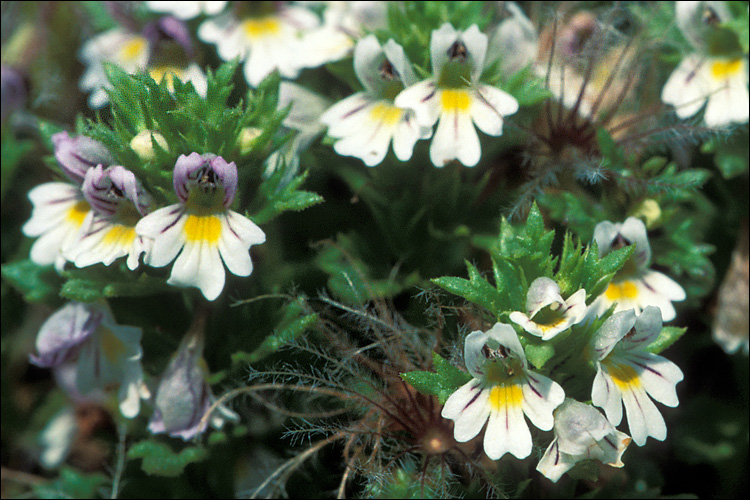Euphrasia picta
(Euphrasia picta)

Description
Euphrasia picta is a species of flowering plant that belongs to the family Orobanchaceae, commonly known as eyebright. It is a small, annual herb that is native to Europe and Asia. It has been used traditionally for medicinal purposes, especially for the treatment of eye disorders. The plant is also popular among herbalists and naturopaths for its anti-inflammatory, astringent, and antimicrobial properties. Taxonomy and Botanical Description: Euphrasia picta was first described by Johann Franz Drège in 1836. The species name "picta" means "painted" or "variegated" in Latin, referring to the color patterns on the leaves of the plant. It is commonly known as "painted eyebright" or "variegated eyebright." The plant grows to a height of 5 to 20 cm and has a prostrate or ascending habit. The stems are branched and quadrangular, and the leaves are opposite, sessile, and ovate to lanceolate in shape. The leaf margins are serrated, and the leaf surface is covered with fine hairs. The flowers are white or pinkish, tubular in shape, and arranged in terminal spikes. The calyx is 5-lobed, and the corolla is 2-lipped, with the upper lip divided into 2 lobes and the lower lip into 3 lobes. The stamens are 4, and the ovary is superior. Distribution and Habitat: Euphrasia picta is native to Europe and Asia, including parts of Russia, China, and Japan. It is also naturalized in North America, where it is found in the northeastern United States and eastern Canada. The plant grows in a variety of habitats, including grasslands, meadows, and rocky slopes. It prefers well-drained soils and can tolerate both acidic and alkaline conditions. Traditional Uses: Euphrasia picta has a long history of traditional use in Europe for the treatment of eye disorders. It was believed to be effective in treating conjunctivitis, blepharitis, and other eye infections. The plant was also used as a remedy for respiratory ailments such as bronchitis and coughs, as well as digestive disorders such as dyspepsia and diarrhea. Modern Uses: Today, Euphrasia picta is used in herbal medicine for its anti-inflammatory, astringent, and antimicrobial properties. It is commonly used in eye drops and ointments for the treatment of conjunctivitis, dry eyes, and other eye irritations. The plant is also used in herbal teas and tinctures for the treatment of respiratory and digestive ailments. It is believed to have a soothing effect on the mucous membranes, reducing inflammation and promoting healing. Side Effects and Precautions: Euphrasia picta is generally considered safe when used as directed. However, some people may experience allergic reactions, especially those who are allergic to other members of the Orobanchaceae family. The plant should not be used by pregnant or breastfeeding women, as its safety in these populations has not been established. Conclusion: Euphrasia picta, also known as painted eyebright, is a small annual herb that is native to Europe and Asia. It has a long history of traditional use for the treatment of eye disorders and other ailments. Today, the plant is used in herbal medicine for its anti-inflammatory, astringent, and antimicrobial properties. While generally considered safe, it should be used with caution and under the guidance of a qualified healthcare professional.
Taxonomic tree:







